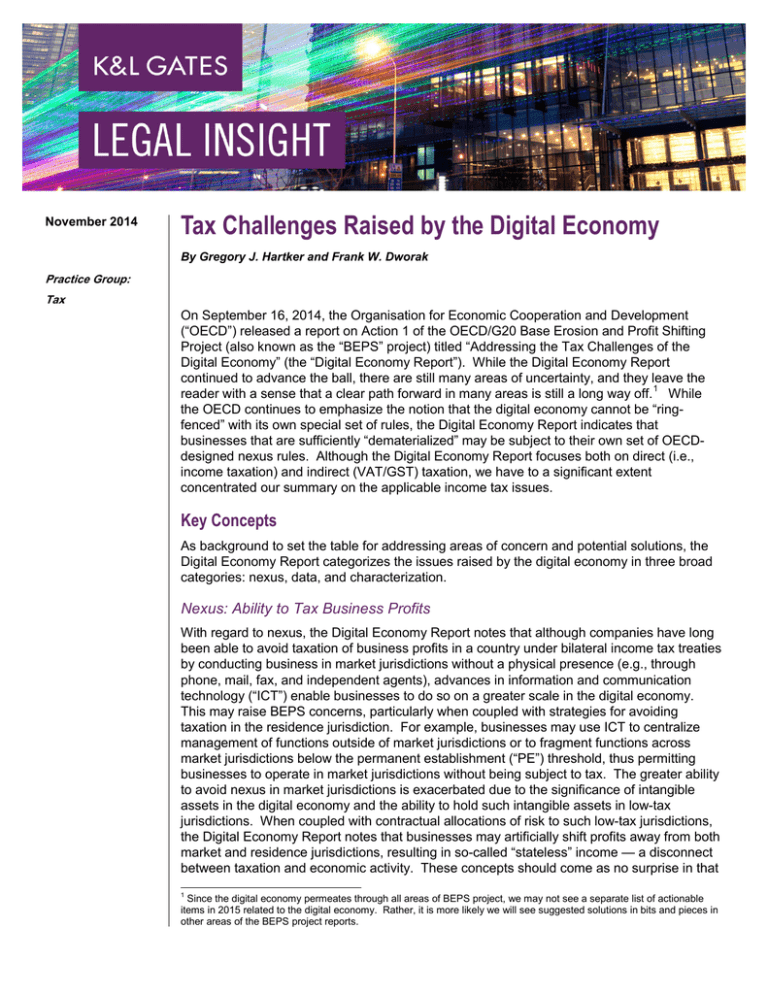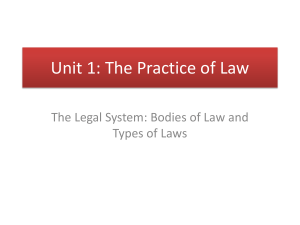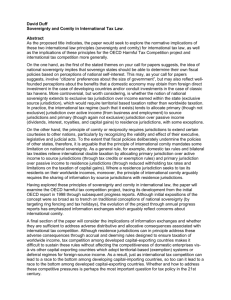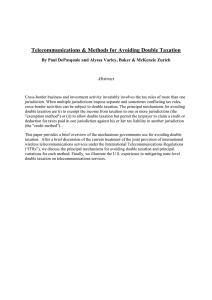
November 2014
Tax Challenges Raised by the Digital Economy
By Gregory J. Hartker and Frank W. Dworak
Practice Group:
Tax
On September 16, 2014, the Organisation for Economic Cooperation and Development
(“OECD”) released a report on Action 1 of the OECD/G20 Base Erosion and Profit Shifting
Project (also known as the “BEPS” project) titled “Addressing the Tax Challenges of the
Digital Economy” (the “Digital Economy Report”). While the Digital Economy Report
continued to advance the ball, there are still many areas of uncertainty, and they leave the
reader with a sense that a clear path forward in many areas is still a long way off. 1 While
the OECD continues to emphasize the notion that the digital economy cannot be “ringfenced” with its own special set of rules, the Digital Economy Report indicates that
businesses that are sufficiently “dematerialized” may be subject to their own set of OECDdesigned nexus rules. Although the Digital Economy Report focuses both on direct (i.e.,
income taxation) and indirect (VAT/GST) taxation, we have to a significant extent
concentrated our summary on the applicable income tax issues.
Key Concepts
As background to set the table for addressing areas of concern and potential solutions, the
Digital Economy Report categorizes the issues raised by the digital economy in three broad
categories: nexus, data, and characterization.
Nexus: Ability to Tax Business Profits
With regard to nexus, the Digital Economy Report notes that although companies have long
been able to avoid taxation of business profits in a country under bilateral income tax treaties
by conducting business in market jurisdictions without a physical presence (e.g., through
phone, mail, fax, and independent agents), advances in information and communication
technology (“ICT”) enable businesses to do so on a greater scale in the digital economy.
This may raise BEPS concerns, particularly when coupled with strategies for avoiding
taxation in the residence jurisdiction. For example, businesses may use ICT to centralize
management of functions outside of market jurisdictions or to fragment functions across
market jurisdictions below the permanent establishment (“PE”) threshold, thus permitting
businesses to operate in market jurisdictions without being subject to tax. The greater ability
to avoid nexus in market jurisdictions is exacerbated due to the significance of intangible
assets in the digital economy and the ability to hold such intangible assets in low-tax
jurisdictions. When coupled with contractual allocations of risk to such low-tax jurisdictions,
the Digital Economy Report notes that businesses may artificially shift profits away from both
market and residence jurisdictions, resulting in so-called “stateless” income — a disconnect
between taxation and economic activity. These concepts should come as no surprise in that
1
Since the digital economy permeates through all areas of BEPS project, we may not see a separate list of actionable
items in 2015 related to the digital economy. Rather, it is more likely we will see suggested solutions in bits and pieces in
other areas of the BEPS project reports.
Tax Challenges Raised by the Digital Economy
the long established brick and mortar PE concept has been viewed by certain governmental
authorities as anachronistic.
Data and Data Gathering
Several issues raised by the significance of data in the digital economy are also discussed.
For example, an enterprise may generate significant value by gathering data in a jurisdiction,
even though the factors for allocating taxable income — i.e., functions, assets, and risks —
are located outside of that jurisdiction. Data gathering also raises questions regarding
allocation of income among jurisdictions where an enterprise generates value through data in
more than one jurisdiction. For example, a business may gather data in one jurisdiction
using technology developed in another jurisdiction, or a business may offer a service to
customers in one jurisdiction for less than cost and then sell the data gathered from such
customers to persons in another jurisdiction (e.g., the gathering and sale of data of users of
online social networks). The Digital Economy Report notes that these issues are not
necessarily distinct from nexus.
Characterization of Income
The Digital Economy Report also identifies several segments of the digital economy that
raise issues as to the appropriate characterization of income. For example, the Digital
Economy Report notes that the character of payments for cloud computing is not addressed
in the existing commentary to the OECD Model Tax Convention, and that it is unclear
whether such payments should be treated as royalties, fees for technical services, service
fees, rent, or business profits.2 In addition, the Digital Economy Report notes that 3D
printing may raise character questions in the case of design licenses for remote printing by
purchasers.
Potential Options to Address Tax Challenges Raised by the Digital Economy
The Digital Economy Report identifies several potential options to restore taxation to both
market jurisdictions and residence jurisdictions (thereby reducing stateless income) through
better alignment of taxation with economic activity, both for income and VATs . With respect
to income taxes, the Digital Economy Report identifies the following potential options:
Modification to the Exemptions from PE Status
One potential option identified is to modify or eliminate the exceptions for preparatory and
auxiliary activities described in paragraph 4 of the OECD Model Tax Convention’s PE article.
The Digital Economy Report notes that, in the digital economy, certain activities that were
considered preparatory or auxiliary in nature (e.g., sales through a storefront) or exempt
(maintenance of a warehouse) may be core business functions in the digital economy (e.g.,
sales through a website).
A New Nexus Based on Digital Presence
Another potential option identified is the establishment of an alternative form of nexus to
address situations in which business activities are conducted wholly digitally. Under this
2
This uncertainty has been around for some time, and practitioners have struggled with a dearth of analogous law,
including under section 7701(e) of the U.S. Internal Revenue Code.
2
Tax Challenges Raised by the Digital Economy
proposal, an enterprise engaged in “fully dematerialized digital activities” could be deemed to
have a taxable presence in a jurisdiction if it maintains a “significant digital presence” in the
economy of that jurisdiction. This option is intended to target businesses that require
minimal physical elements in the market jurisdiction for the performance of core activities.
The Digital Economy Report identifies a number of potential elements to test whether an
enterprise is engaged in fully dematerialized digital activities, including a focus on core
business and the manner in which an enterprise generates the majority of its profits.
Unfortunately, this approach may pick winners and losers based in part on enterprise-wide
business characteristics rather than the focusing on the functions of the enterprise that relate
to the generation of income in the relevant market. That being said, businesses employing
“dematerialized” digital activities are now on notice that a special set of rules may be
applicable to their operations in the future.
Replacing PE with Significant Presence
The Digital Economy Report also includes a potential option that would involve replacement
of the existing PE concept with a “significant presence” test. It is stated that the significant
presence test would take account of the changing nature of customer relationships in the
digital economy while continuing to rely in part on physical presence. The criteria for this test
would include:
• Relationships with customers or users extending over six months, combined with some
physical presence in the country, directly or via a dependent agent;
• Sale of goods or services by means involving a close relationship with customers in the
country, including (i) through a website in the local language, (ii) offering delivery from
suppliers in the jurisdiction, (iii) using banking and other facilities from suppliers in the
country, or (iv) offering goods or services sourced from suppliers in the country; and
• Supplying goods or services to customers in the country resulting from or involving
systematic data gathering or contributions of content from persons in the country.
Creation of a Withholding Tax on Digital Transactions
In addition to addressing nexus issues through changes to the PE concept, the Digital
Economy Report identifies a potential option involving the introduction of a withholding tax on
certain payments made by residents of a jurisdiction for digital goods and services of a
foreign provider. It is noted that the withholding tax could be introduced as a standalone
provision to address the ability to conduct significant digital business in a market jurisdiction
without triggering the current PE rules, or the withholding tax could be used as an
enforcement tool for one or more of the new nexus standards discussed above. However,
compliance may be problematic with respect to transactions involving direct dealings with
end-user individuals, similar to the compliance issues that affect self-charged VAT and the
reporting and paying of use taxes in the United States. Thus, the Digital Economy Report
suggests that financial institutions that process payments may be charged with acting as
withholding agents.
Other Items of Note
3
Tax Challenges Raised by the Digital Economy
The Digital Economy Report also identifies several other noteworthy topics, including some
that raise unique approaches or concerns.
Multi-sided Business Models
Multi-sided business models, which are described as “a business in which multiple distinct
groups of persons interact through an intermediary or platform, and the decisions of each
group of persons affect the outcome for the other groups of persons through a positive or
negative externality,” may raise some perceived unique issues.3 A multi-sided business
enterprise can exploit the information or data gathered via the targeted sale of products or
the information generated by such user participation. There is a concern that jurisdictions
may not adequately account for/capture, via the imposition of tax, the value springing from
the exploitation of data generated by or gathered from their residents. Attributing and
accounting for such “value” would seem to be a difficult transfer pricing problem to say the
least, and the Digital Economy Report offers no concrete options to address this issue .
Introduction of a Bandwidth or “Bit” Tax
The Digital Economy Report also identifies a potential option involving taxation of a website’s
use of bandwidth in a jurisdiction. It is noted that the bandwidth tax would be progressive
and would only apply if bandwidth use exceeded a minimum threshold. Further, in order to
maintain equity between digital businesses and traditional businesses, the Digital Economy
Report envisions that the bandwidth tax would be creditable against the corporate income
tax.
Evaluation of Potential Options and Next Steps
The Digital Economy Report’s identification of the potential options described above is not a
final evaluation of the options, and the Digital Economy Report notes that none of the options
have been adopted at this time. The Task Force on the Digital Economy will further evaluate
and develop the potential options in light of anticipated work in other BEPS action plans
(forthcoming in late 2015), further consider whether the potential options are proportionate to
the tax challenges raised by the digital economy, and decide whether the potential options
comport with the basic tax principles of neutrality, efficiency, certainty and simplicity,
effectiveness and fairness, and flexibility and sustainability. Thus, there is still time for
stakeholder input.
As a final note, for what it is worth, the Digital Economy Report may leave the reader with the
impression that the OECD is moving further toward “market”-based sourcing with respect to
the digital exploitation of goods and services and data gathering and usage, which could, in
turn, lead to the erosion of PE as a meaningful concept. We have seen this work its way
through many U.S. states, which have abandoned physical presence thresholds with nexus
standards based on dollars generated in the relevant states. Readers of the Digital
Economy Report may be left wondering whether formulary apportionment is far off.
3
Digital Economy Report at ¶ 4.3.4
4
Tax Challenges Raised by the Digital Economy
Authors:
Gregory J. Hartker
greg.hartker@klgates.com
+1.415.882.8099
Frank W. Dworak
frank.dworak@klgates.com
+1.949.623.3585
Anchorage Austin Beijing Berlin Boston Brisbane Brussels Charleston Charlotte Chicago Dallas Doha Dubai Fort Worth Frankfurt
Harrisburg Hong Kong Houston London Los Angeles Melbourne Miami Milan Moscow Newark New York Orange County Palo Alto Paris
Perth Pittsburgh Portland Raleigh Research Triangle Park San Francisco São Paulo Seattle Seoul Shanghai Singapore Spokane
Sydney Taipei Tokyo Warsaw Washington, D.C. Wilmington
K&L Gates comprises more than 2,000 lawyers globally who practice in fully integrated offices located on five
continents. The firm represents leading multinational corporations, growth and middle-market companies, capital
markets participants and entrepreneurs in every major industry group as well as public sector entities, educational
institutions, philanthropic organizations and individuals. For more information about K&L Gates or its locations,
practices and registrations, visit www.klgates.com.
This publication is for informational purposes and does not contain or convey legal advice. The information herein should not be used or relied upon in
regard to any particular facts or circumstances without first consulting a lawyer.
© 2014 K&L Gates LLP. All Rights Reserved.
5








